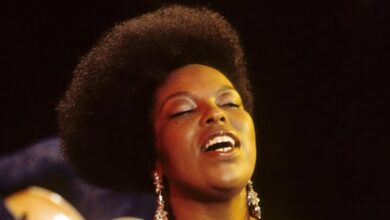Bill Haley & His Comets’ ‘Rock Around the Clock’ (1954): The Song That Defined Rock ‘n’ Roll’s Revolution
In 1954, Rock Around the Clock by Bill Haley & His Comets burst onto the scene, forever changing the landscape of popular music. While it initially had a modest reception, the song’s fortunes dramatically shifted when it was featured in the 1955 film Blackboard Jungle, a gritty drama about juvenile delinquency. From that moment on, Rock Around the Clock became an unstoppable force, widely regarded as the first rock ‘n’ roll song to top the Billboard charts. It was more than just a hit—it was a cultural phenomenon that introduced mainstream audiences to the rebellious, electrifying energy of rock music.
Bill Haley, a Pennsylvania-born musician, wasn’t an obvious candidate to spearhead the rock revolution. A former country and western artist, he started his career with The Saddlemen, playing western swing before transitioning into rhythm-driven, danceable music. With his trademark kiss curl and jovial stage presence, Haley didn’t fit the mold of the youthful, rebellious rockers that would follow him. Yet, his musical instincts were impeccable—he had a knack for blending rhythm and blues with country elements, creating a hybrid sound that would become rock ‘n’ roll. By the early 1950s, his band, The Comets, had begun experimenting with a faster, more energetic style, paving the way for what would become their defining moment.
The song itself was written in 1952 by Max C. Freedman and James E. Myers (under the pseudonym Jimmy DeKnight). Initially, it was recorded by Sonny Dae & His Knights, but their version went largely unnoticed. Haley and his group, however, saw its potential. Recorded on April 12, 1954, at Pythian Temple studios in New York, Rock Around the Clock featured a driving beat, a punchy saxophone solo, and a raucous, infectious energy that made it impossible to sit still. Danny Cedrone’s now-legendary guitar solo, originally lifted from Haley’s earlier recording Rock the Joint, added a level of excitement that would become a template for future rock solos.
Despite its groundbreaking sound, Rock Around the Clock didn’t immediately take off. Upon its release in May 1954, it was largely overshadowed by Haley’s other hit, Shake, Rattle and Roll, which itself was a pivotal rock ‘n’ roll track. It wasn’t until Blackboard Jungle hit theaters in 1955 that Rock Around the Clock became the defining anthem of teenage rebellion. The film, which depicted the struggles of troubled youth in inner-city schools, used the song in its opening credits, giving it an association with teenage energy, defiance, and a break from the past.
The reaction was explosive. Teenagers flocked to theaters, dancing in the aisles and treating the film’s opening sequence like a rock concert. By July 1955, Rock Around the Clock had climbed to No. 1 on the Billboard pop chart, staying there for eight weeks. It became the first rock ‘n’ roll song to achieve such dominance, effectively proving that the genre wasn’t just a passing fad—it was the future. The song also gained international acclaim, charting in the UK and around the world, turning rock ‘n’ roll into a truly global movement.
More than just a commercial success, Rock Around the Clock symbolized a cultural shift. It signified the moment when rock ‘n’ roll broke into the mainstream, challenging the dominance of big band, jazz, and traditional pop. The song’s relentless, pounding rhythm made it clear that rock wasn’t just about melodies—it was about movement, attitude, and an energy that resonated with the youth. Parents and conservative critics saw it as a threat, calling it dangerous and wild, but that only added to its appeal.
For Bill Haley, the success of Rock Around the Clock opened doors he had never imagined. Suddenly, he was at the forefront of a new musical revolution, performing on television shows like The Ed Sullivan Show and embarking on international tours. He became the first rock ‘n’ roll artist to tour Europe, sparking Beatlemania-level hysteria years before The Beatles even formed. However, Haley’s reign at the top was relatively short-lived. As the 1950s progressed, younger, edgier artists like Elvis Presley and Chuck Berry took rock in a different direction, leaving Haley somewhat in their wake.
Nonetheless, the song’s influence was immeasurable. It was covered by countless artists over the years, from The Isley Brothers to The Sex Pistols, each bringing their own spin to its raw, foundational energy. Even artists outside of rock ‘n’ roll acknowledged its impact—jazz musicians, country singers, and punk rockers alike recognized Rock Around the Clock as a seismic moment in musical history.
Beyond its influence on artists, the song remained a staple in pop culture. It was revived in the 1970s as the opening theme for the hit TV show Happy Days, introducing a new generation to its infectious rhythm. The song continued to make appearances in films, commercials, and sporting events, keeping its legacy alive decades after its initial release.
While Bill Haley never quite maintained his initial superstardom, his contribution to rock ‘n’ roll is undeniable. His music laid the groundwork for what would follow, bridging the gap between rhythm and blues and the electrified, rebellious sounds of the late ‘50s and beyond. Even after Haley’s passing in 1981, Rock Around the Clock remained an enduring symbol of the birth of rock, forever linked to the spirit of teenage rebellion and freedom.
It is difficult to overstate the importance of Rock Around the Clock. It was the song that turned rock ‘n’ roll from an underground movement into the dominant cultural force of the late 20th century. Without it, the explosion of rock music—The Beatles, The Rolling Stones, punk rock, heavy metal—might have taken a very different path. More than just a hit record, it was a revolution in three minutes of pure, unfiltered energy.
Today, Rock Around the Clock is more than just a nostalgic throwback—it’s an essential chapter in the history of music. It represents the dawn of an era, the spark that ignited a wildfire. Whether blasting from jukeboxes in the 1950s or being rediscovered by younger audiences decades later, its infectious beat and rebellious spirit ensure that it will never be forgotten.



